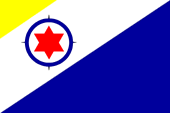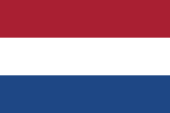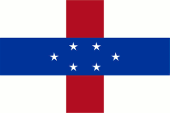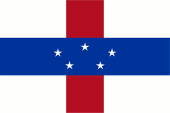Bonaire |
|
|
|
| Übersicht – Contents: | |
Diese Seite ist Teil des Projektes
Bonaire |
|
|
|
| Übersicht – Contents: | |
Flagge – Flag: |
|
 |
Flagge von Bonaire – flag of Bonaire, Seitenverhältnis – ratio = 2:3, Quelle/Source: Corel Draw 4 |
historische Flaggen – historical Flags: |
|
 |
1635–1807, 1815–1959, Flagge der Niederlande – flag of the Netherlands, Seitenverhältnis – ratio = 2:3, Quelle/Source nach/by: World Statesmen |
 |
1959–1986, Flagge der Niederländischen Antillen – flag of the Netherlands Antilles, Seitenverhältnis – ratio = 2:3, Quelle/Source nach/by: Wikipedia (D) |
 |
1986–2010, Flagge der Niederländischen Antillen – flag of the Netherlands Antilles, Seitenverhältnis – ratio = 2:3, Quelle/Source nach/by: Wikipedia (D) |
Bedeutung/Ursprung der Flagge – Meaning/Origin of the Flag: |
|
Die Flagge von Bonaire
wurde am 15.12.1981 eingeführt. Sie ist diagonal geteilt. Der untere Teil ist blau, der
obere Teil ist wieder diagonal zwischen weiß und gelb geteilt. In dem so entstehenden
breiten weißen diagonalen Zwischenstreifen befindet sich die schematische Darstellung ein
Kompasses mit einem sechszackigen roten Stern darin. Für die Erklärung von Bedeutung und
Ursprung der Flagge gibt es mehrere Varianten:
|
The flag of Bonaire was
introduced on the 15th of December in 1981. It is diagonally divided. The lower part is
blue, the upper part is diagonally divided again between white and yellow.
In the in this way arising broad white diagonal mean stripe is placed the schematic
representation of a compass with a six-pointed red star in it. To declare meaning and origin of the Flag there are some ways:
|
| Quelle/Source: Flaggen Enzyklopädie | |
Wappen – Coat of Arms: |
|
 |
Wappen von Bonaire – coat of arms of Bonaire, Quelle/Source nach/by: Wikipedia (D) |
Bedeutung/Ursprung des Wappens – Meaning/Origin of the Coat of Arms: |
|
| Das Wappen zeigt einen blauen Schild, darauf ein goldenes Steuerrad und ein weißer Herzschild, auf dem Herzschild erscheint das Symbol von der Flagge, der stilisierte Kompass mit dem roten Stern in der Mitte. Über dem Schild eine goldene Krone. Der rote Stern steht für die Inselbewohner und die sechs Ecken symbolisieren die sechs Verwaltungsbezirke der Insel. | The coat of arms shows
a blue shield on it a golden steering wheel and a white heart shield, on the heart shield
appears the symbol of the flag, the stylized compass with the red star in the middle.
Above the shield is placed a golden crown. The red star stands for the islanders and the six corners symbolize the
six counties of the island. |
| Quelle/Source: Wikipedia (D) | |
| Landkarte – Map: |
|
Zahlen und Fakten – Numbers and Facts: |
|
|
|
|
|
|
|
|
|
|
|
|
|
|
|
|
|
|
|
Geschichte: |
|
bis 2010: => siehe Niederländische Antillen 10.10.2010 · die Niederländischen Antillen werden administrativ aufgelöst – Bonaire wird eine Besondere Gemeinde der Niederlande, die jedoch zu keiner Provinz gehört |
History: |
|
to 2010: => look Netherlands Antilles 10th of October 2010 · Netherlands Antilles become dissolved administratively. Bonaire becomes a special municipality of the Netherlands, but belongs not to any province |
| Quelle/Source: Wikipedia (D) |
Ursprung des Landesnamens – Origin of the Country's Name: |
|
| Das Wort "Bonaire" geht auf den Namen "Bonay" zurück, den die ehemaligen Ureinwohner vom Stamme der Arawak ihrer Insel gaben. Es bedeutet: "flaches Land" oder "tiefes Land". | The word "Bonaire" goes back to the name "Bonay", which gave the former natives from the tribe of the Arawak of their island. It means "flat land" or "deep down country". |
| Quelle/Source: www.travelbook.de | |
| Nach anderen Quellen geht der Name "Bonaire" auf das französische Wort "bon aire" zurück, was "gute Luft" bedeutet. | According to other sources name "Bonaire" has its roots in the French word "bon aire", which means "good air". |
| Quelle/Source: Handbuch der geographischen Namen | |